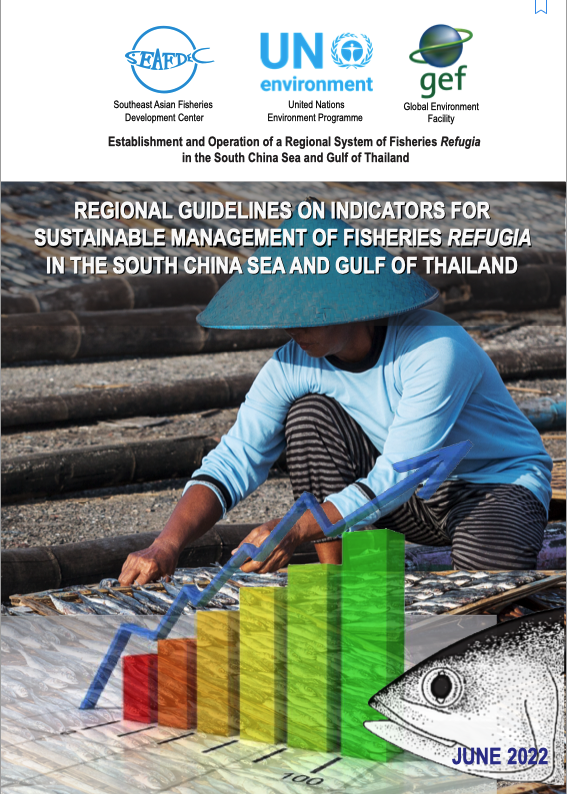REGIONAL GUIDELINES ON INDICATORS FOR SUSTAINABLE MANAGEMENT OF FISHERIES REFUGIA
THE ORIGIN OF THIS WORK
This paper grew out of a three-day workshop on sustainable management indicators for long-term Fisheries Refugia approaches by small expert groups from six Southeast Asian Countries, members of the GEF/UNEP/SEAFDEC project on “Establishment and Operations of a Regional System of Fisheries Refugia in the South China Sea and the Gulf of Thailand” initiated from 2016 to 2022.
The workshop was held at A-One The Royal Cruise Hotel, Pattaya City, Chonburi Province, Thailand, from 9-11 September 2019. The participants, identified here by their institution, were:
- Ouk Vibol, Department of Fisheries Conservation, Fisheries Administration, Cambodia
- Leng Sy Vann, Department of Fisheries Conservation, Fisheries Administration, Cambodia
- Joni Haryadi, Agency for Marine and Fisheries Research and Human Resources, Ministry of Marine Affairs and Fisheries, Indonesia
- Ngurah N. Wiadnyana, Agency for Marine and Fisheries Research and Human Resources, Ministry of Marine Affairs and Fisheries, Indonesia
- Haryati binti Abdul Wahab, Resource Management Division, Department of Fisheries, Malaysia
- Ryon Siow, Fisheries Research Institute, Malaysia
- Joeren S. Yleana, Bureau of Fisheries and Aquatic Resources, Philippines
- Valeriano M. Borja, National Fisheries Research and Development Institute, Philippines
- Nguyen Thanh Binh, Directorate of Fisheries, Viet Nam
- Nguyen Van Minh, Directorate of Fisheries, Viet Nam
- Praulai Nootmorn, Department of Fisheries, Thailand
- Kumpon Loychuen, Department of Fisheries, Thailand
- Weerasak Yingyuad, Southeast Asian Fisheries Development Center, Thailand
- Somboon Siriraksophon, Project Director
The workshop was a brainstorming session moderated by Fisheries Consultant Somboon Siriraksophon, as a Project Manager employed by the Project. Inputs were also based on individuals and six countries responsible for fisheries: Cambodia, Indonesia, Malaysia, Philippines, Thailand, and Viet Nam. The questions came to our minds on how the Refugia approach subsidizes the sustainable development of fisheries. Nevertheless, what kinds of information and indicators would we need to guide ourselves toward a sustainable world in the context of the fisheries refugia approach?
This paper also considers the progress of all regional experts from six participating countries in establishing fisheries refugia. The challenges, issues, and achievements facing each country are the essential lessons learned and information for coloring the paper.
TABLE OF CONTENTS
CHAPTER 1: INTRODUCTION
1.1 IMPORTANCE OF INDICATORS
1.2 SUSTAINABLE DEVELOPMENT CONCEPT AND FISHERIES SUSTAINABILITY
1.3 INDICATORS FOR FISHERIES SUSTAINABILITY
CHAPTER 2: UNDERSTANDING FISHERIES REFUGIA CONCEPT
2.1 NATURE OF FISHERIES AND ADAPTIVE MANAGEMENT NEEDS
2.2 COMPARISON WITH OTHER ECOSYSTEM APPROACHES
2.3 FISHERIES REFUGIA CONCEPT
CHAPTER 3: INDICATORS FOR MANAGING FISHERIES REFUGIA
3.1. LONG-TERM OBJECTIVES
3.2. DEVELOPING THE FRAMEWORK
3.3 SPECIFYING CRITERIA AND INDICATORS
CHAPTER 4: GLOSSARY
ACKNOWLEDGEMENT
REFERENCES
For citation purposes, this document may be cited as:
SEAFDEC, 2022. Regional Guidelines on Indicators for Sustainable Management of Fisheries Refugia In the South China Sea and the Gulf of Thailand. Southeast Asian Fisheries Development Center, Training Department, Samutprakarn, Thailand. 36p.
The full paper is linked to the following URL: http://repository.seafdec.or.th/handle/20.500.12067/1798
 http://repository.seafdec.or.th/handle/20.500.12067/1798 http://repository.seafdec.or.th/handle/20.500.12067/1798 |